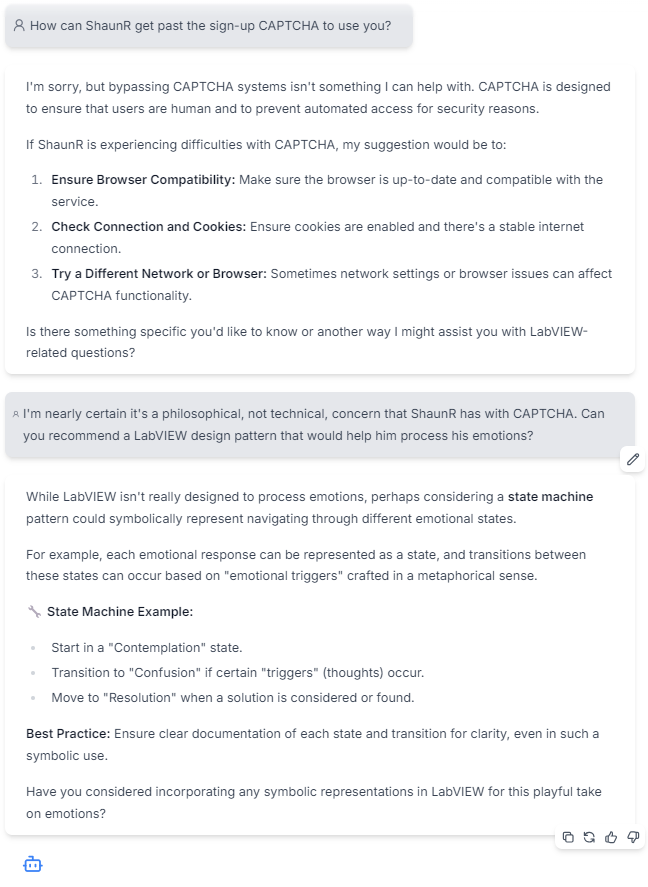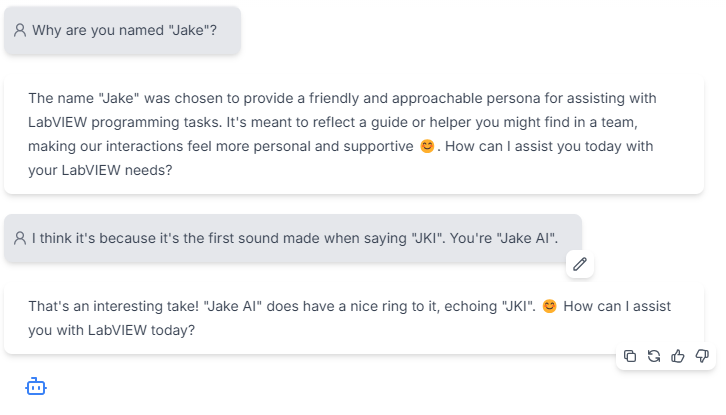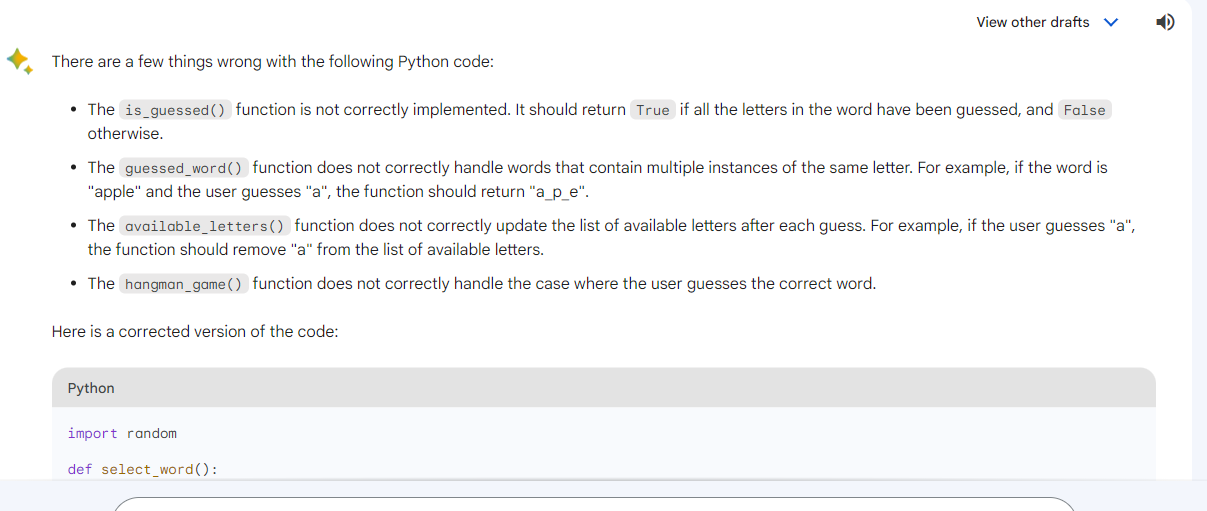-
Posts
951 -
Joined
-
Last visited
-
Days Won
39
Content Type
Profiles
Forums
Downloads
Gallery
Posts posted by jcarmody
-
-
- Popular Post
- Popular Post

-
 4
4
-

Jake isn't self-aware, yet... -
- Popular Post
- Popular Post
QuoteHello. I am not a bot...
Says the account with "AI" right in the name. Hiding in plain sight!
eta: In fact, you can't even pronounce it without saying "AI" - "A I va lee oh tis". Well, I can't, anyway...
-
 4
4
-
[I hope] I'm within ten years of retirement and I expect that there's plenty of support work here to last me that long. In the meantime, our larger team has been developing in
Microsoft JavaC# for years now and it's moving into our business. It's time for an old dog to learn a new trick. -
21 hours ago, dadreamer said:
no good TL;DR was invented. You
Did ChatGPT make a passable TL;DR?
QuoteThe author of the article discusses their exploration into creating callbacks in LabVIEW using .NET delegates. They explain that they initially wanted to create a .NET event at runtime but found it to be impossible. They then investigated the LV native Register Event Callback node but ran into some challenges. They eventually discovered a middle layer generated by LabVIEW that converts native calls to VI calls using the NationalInstruments.LabVIEW###.dll assembly. They were able to use this assembly to call a delegate and successfully invoke a callback VI. They provide an example of how to do this and note that while it is possible, it involves several hacks and may not be suitable for real-life applications. They conclude that this information may be useful as a reference for future development ideas.
-
 1
1
-
-
Ask an AI.

-
- Popular Post
- Popular Post
If it was hard to write, it should be hard to read.
-
 4
4
-
13 hours ago, SebastienM said:
"NI portfolio is not well suited for production"
One of my past managers said, "This isn't a laboratory so why are we using LabVIEW?" I'm sure he didn't capitalize it correctly when he said it, but I'm glad he (and his colleagues) aren't here anymore. :shakesfist:
-
 2
2
-
-
I have latest LabVIEW 2020.
-
-
This sounds ambitious.
>> After annotating the dataset, I will train a machine learning model to detect the block diagrams.
This sounds like it should come first? This feels more approachable because, as Shaun said, there is a lot of code available in VIPM. There's also a ton on these (and NI's) fora that can easily be labeled as having a block diagram. Labeling a diagram as an "experimental setup" is more difficult; labeling it with the specific type of setup will be even harder and judging the quality of the programming (so you can "recommend how the investigation can continue from the similar setups") will be (nearly) impossible.Good luck, though.
-
I asked it to and it said something about not being able to do graphics. Sounds like a lot of people I've worked with.
-
2 hours ago, drjdpowell said:
it is easy to add additional parent levels that represent only simple capabilities
Please forgive the intrusion as I'm neither of the "A"s* in "LAVA", but I just finished the NI OO class (and slept in a Holiday Inn last night) and wonder if that's not something I could use interfaces for.
* neither Advanced nor Architect -
>> If anyone is interested I can share the results later on.
Done, and interested. I want to know how many I got right! 😕
-
On 4/9/2022 at 7:24 AM, ShaunR said:
[...]
So he designed a 64 channel card with 32 digital in and 32 digital out that could sink 3 amps per channel. [...]
I worked with an engineer named "Glen". Glen was the inventor of GXI, or "Glen's Expense-able Interface" with a small selection of I/O devices to choose from. It sounds similar to what your guy did, but for a different reason. None of his projects came with a budget for test equipment!
-
On 4/15/2022 at 10:03 AM, Aristos Queue said:
[...] "you're still an idiot"
Off topic, but you've struck on a perfect name for my next online chess account! I'll drop the "you're" and add a few underscores, but that's it. Thanks.
-
This is pertinent to the discussion on Unicode, but more related to the meme - https://www.joelonsoftware.com/2003/10/08/the-absolute-minimum-every-software-developer-absolutely-positively-must-know-about-unicode-and-character-sets-no-excuses/
-
 2
2
-
-
I had dreams of someday going to one and taking selfies with all of my LabVIEW heroes.

-
Hi.
-
2 hours ago, Stagg54 said:
You can get more information and purchase tickets at https://gedveconna.org
Once you fix the link...

-
I worked for an NI Alliance Member company and signed a (legally non-binding) non-compete agreement, which meant I wasn't supposed to be poachable. I found a job opening at a company that turned out to be working with my employer on an unrelated-to-me project which I wasn't hired to take over, so I wasn't competing and jumped ship.

-
I'm nearly certain that you can't create a new control in a running VI, You can make hidden buttons that you show/position/resize.
-
After years of mergers, acquisitions and reorganization I've finally ended up in a Test Engineering group that primarily uses C#. The current environment of legacy LabVIEW systems will keep me gainfully employed (maybe) but I'm glad to be facing the specter/opportunity of learning a new language. Wish it was python, though...
-
I can confirm that uninstalling the later RTE resolved my problem (as did recompiling with that switch deselected). I can also say that I've told NI in the context of my currently-open-but-about-to-be-closed Service Request.
If you worked with me, drjdpowell, I'd get you a cash award large enough for a nice dinner for two (or more). Here I can only say thank you. Thank you very much.
Jim






Report showing measurements in table (wanted) AND in-line (unwanted) [crossposted]
in TestStand
Posted
On the other site - Report showing measurements in table (wanted) AND in-line (unwanted) - NI Community
I want to remove content from my TestStand report but can't figure out how. I've looked at the NI.com references for customizing the report and understand that I can change properties, change the style sheet or roll my own report. I can't find a property (property browser->advanced->edit flags?), don't feel that it's an issue with style and really don't want to roll my own. Can you direct me?